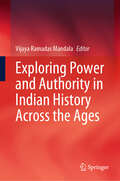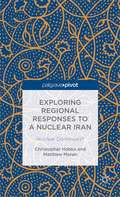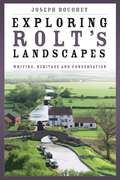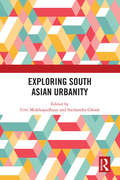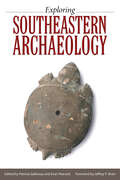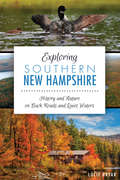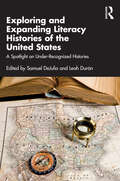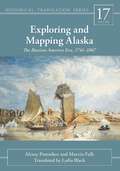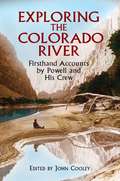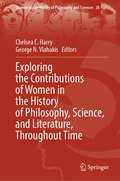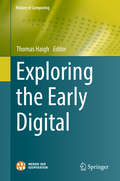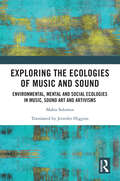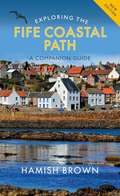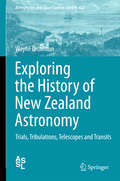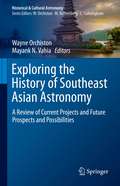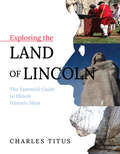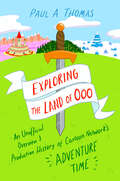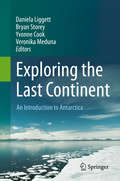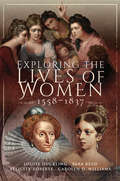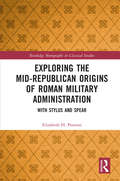- Table View
- List View
Exploring Power and Authority in Indian History Across the Ages
by Vijaya Ramadas MandalaThis book volume presents a nuanced perspective on comprehending power and authority in Indian history by offering a collection of case studies from different regions of India from different periods. The chapters in the book shed light on the sociological, cultural, economic, and historical dimensions of power and authority. The agency is also critiqued, offering fresh perspectives on the dominant ideologies of the ruling groups and the responses from the subjugated. By examining the intricacies of power within socio-political and cultural orders, this book provides valuable insights for readers interested in understanding the dynamics of power in Indian history. It also offers an academic exploration of Indian history, illuminating various aspects of diverse political structures from ancient to modern times from the historical framework of power, its dissenting voices, and complex histories. This volume is a valuable resource for historians, academics, and researchers interested in the field of Indian history or the history of South Asia.
Exploring Regional Responses to a Nuclear Iran: Nuclear Domi-noes?
by Christopher Hobbs Matthew MoranThis book challenges the widely held assumption that a nuclear-armed Iran would provoke a proliferation cascade in the Middle East. Arguing that a domino effect is by no means inevitable, the authors set out a number of policy measures that could be enacted by the international community to reduce this risk.
Exploring Rolt's Landscapes: Writing, Heritage and Conservation
by Joseph BougheyL.T.C. Rolt is still a towering figure in the fields of inland waterways, preserved railways and post-war conservation. A bridge and a locomotive have been named after him, and there is a Rolt Prize, Rolt Fellows and an annual Rolt Lecture. He played a crucial role in the revival of Britain's inland waterways and pioneered the first preserved narrow-gauge railway. In this fascinating series of linked essays, Joseph Boughey explains aspects of Rolt’s earlier life and work, and sets his writing and practice in a broader context, considering such themes as the landscapes Rolt knew; the nature of travel and ‘country’ writing; the 1930s/40s organicist movement; English canals and navigable rivers from the 1930s to the ‘50s, including practical campaigning; the background to early railway preservation; and the nature of craft, craftspeople and preservation.
Exploring South Asian Urbanity
by Suchandra Ghosh Urvi MukhopadhyayThis book looks at the typologies of cities and ideas of urbanity. Focusing specifically on cities in South Asia, it analyses the unique planning concepts, archaeology, art, culture, life, and philosophy of various cities of ancient and modern South Asia. The book explores the concept of urbanity and the idea of an ideal city; it interrogates general notions of urbanity by juxtaposing city life in various periods and geographies of South Asia. By analysing the demography, architecture, rituals, and culture of various cities, it looks at the different spatialities of these places in terms of their size, population, commerce, and philosophy as well as the reasons behind the transformation of these places into urban centres. Drawing from various archeological and literary sources, the volume includes rich details about heterogeneity, rituals, festivals, social stratification, penal systems, famines, and insurrections in ancient cities as well as modern cities like Lahore, Dhaka, and Calcutta, among many others in South Asia. This book will be of interest to researchers and students of ancient and modern history, archaeology, urban studies, urban and town planning, urban sociology, urban geography, cultural studies, post-colonial studies, ancient and medieval architecture, heritage studies, conservation studies, and South Asian studies.
Exploring Southeastern Archaeology
by Patricia Galloway Evan PeacockContributions by Keith A. Baca, Jeffrey P. Brain, Samuel O. Brookes, Ian W. Brown, Philip J. Carr, Jessica Crawford, Patricia Galloway, Alison M. Hadley, Christopher T. Hays, Edward R. Henry, Cliff Jenkins, Jay K. Johnson, Evan Peacock, Janet Rafferty, Maria Schleidt, Mary Evelyn Starr, James B. Stoltman, Andrew M. Triplett, Melissa H. Twaroski, and Richard A. Weinstein This volume includes original scholarship on a wide array of archaeological research across the South. One essay explores the effects of climate on early cultures in Mississippi. Contributors reveal the production and distribution of stone effigy beads, which were centered in southwest Mississippi some 5,000 years ago, and trace contact between different parts of the prehistoric Southeast as seen in the distribution of clay cooking balls. Researchers explore small, enigmatic sites in the hill country of northern Mississippi now marked by scatters of broken pottery and a large, seemingly isolated "platform" mound in Calhoun County. Pieces describe a mound group in Chickasaw County built by early agriculturalists who subsequently abandoned the area and a similar prehistoric abandonment event in Winston and Choctaw Counties. A large pottery collection from the famous Anna Mounds site in Adams County, excavations at a Chickasaw Indian site in Lee County, camps and works of the Civilian Conservation Corps in the pine hill country of southern Mississippi, and the history of logging in the Mississippi Delta all yield abundant, new understandings of the past. Overview papers include a retrospective on archaeology in the National Forests of north Mississippi, a look at a number of mound sites in the lower Mississippi Delta, and a study of how communities of learning in field archaeology are built, with prominent archaeologist Samuel O. Brookes's achievements as a focal point. History buffs, artifact enthusiasts, students, and professionals all will find something of interest in this book, which opens doors on the prehistory and history of Mississippi.
Exploring Southern New Hampshire: History and Nature on Back Roads and Quiet Waters (Natural History)
by Lucie BryarWalkers, bikers, paddlers and snowshoers can encounter relics of the past and their incredible tales from Keene to the Seacoast. "Exploring Southern New Hampshire" takes history off the page, out of the car and into the welcoming pine-scented woods and pristine waters of the Granite State. Hike Mount Monadnock, paddle the Nashua River and retrace Lincoln's footsteps down Exeter's streets. Experience the legacy of a women's sawmill at Turkey Pond from the waters that powered it. Visit Cathedral of the Pines, a beautiful outdoor altar built with stones from historic sites around the world. Set sail on the Piscataqua River onboard a gundalow and learn about the region's rich maritime history. Local history explorer and nature lover Lucie Bryar leads readers through the Monadnock, Merrimack Valley and Seacoast regions. Granite State natives and transplants alike will explore trails and waterways to gain a new appreciation for the history hidden in natural New Hampshire.
Exploring The Limits of The Human Through Science Fiction
by Gerald Alva MillerThrough its engagement with different kinds of texts, Exploring the Limits of the Human through Science Fiction represents a new way of approaching both science fiction and critical theory, and its uses both to question what it means to be human in digital era.
Exploring World History Part 1
by Ray Notgrass"This curriculum provides credit in three high school subjects: world history, English, and Bible. The 150 lessons are divided into thirty units of five lessons each. Since a typical school year has thirty-six weeks, you have some flexibility in completing the course. You can take two weeks to complete a unit when you find a topic particularly interesting or when your schedule is especially busy. Families are free to choose how they want to schedule the course, but many families choose to begin a unit on Monday and finish it on Friday. On the first day of a unit, you and a parent should read the unit introduction. Here you will find a brief overview of the unit; a list of lessons for that unit; a Bible passage to memorize; a list of books used with that unit; choices for a project for that unit; and, when a literature title is begun, an introduction to that book. After reading the introduction, choose a project to complete by the end of the unit and make a schedule for how to complete it. Find the memory work for the week in the Bible translation of your choice. "
Exploring World History Part 2
by Ray NotgrassThe book you have before you is a direct result of an event that occurred during the Renaissance. The copy of the Bible that you read is a direct result of that same event, as are your other books, newspapers and magazines, and all printed materials. The printing process used today is different from that which came into existence over five hundred years ago, but a direct line connects the two processes. In the mid-15th century, Johann Gutenberg developed a printing press with movable type. The full impact of this invention on our world is hard to calculate.
Exploring World History Student Review
by Ray NotgrassThe Exploring World History Student Review Book is part of the Notgrass Exploring World History one-year high school curriculum. It includes review questions (covering each lesson, selected readings from In Their Words, and each of the recommended works of literature), commentary on Bible readings, and literary analysis of the twelve titles suggested for students.
Exploring and Expanding Literacy Histories of the United States: A Spotlight on Under-Recognized Histories
by Samuel DeJulio Leah DuránExploring and Expanding Literacy Histories of the United States brings together new scholarship and critical perspectives hitherto missing from dominant narratives to offer a racially, ethnically, and linguistically diverse record of the history of American reading instruction. This book addresses the many important developments in the history of literacy in the United States that occurred outside of mainstream public education, in marginalized communities in and outside of traditional school contexts.Instead of a “top-down” approach of prominent thinkers and theorists, the book intends to cover key blind spots, including literacy education in Indigenous nations, and how marginalized groups have fought for access to education, by applying a critical lens to the under-recognized histories of literacy.This volume is essential reading for courses on History of Reading Education and Foundations of Literacy.
Exploring and Mapping Alaska: The Russian America Era, 1741-1867 (Rasmuson Library Historic Translation)
by Alexey Postnikov Marvin FalkRussia first encountered Alaska in 1741 as part of the most ambitious and expensive expedition of the entire eighteenth century. For centuries since, cartographers have struggled to define and develop the enormous region comprising northeastern Asia, the North Pacific, and Alaska. The forces of nature and the follies of human error conspired to make the area incredibly difficult to map. Exploring and Mapping Alaska focuses on this foundational period in Arctic cartography. Russia spurred a golden era of cartographic exploration, while shrouding their efforts in a veil of secrecy. They drew both on old systems developed by early fur traders and new methodologies created in Europe. With Great Britain, France, and Spain following close behind, their expeditions led to an astounding increase in the world’s knowledge of North America. Through engrossing descriptions of the explorations and expert navigators, aided by informative illustrations, readers can clearly trace the evolution of the maps of the era, watching as a once-mysterious region came into sharper focus. The result of years of cross-continental research, Exploring and Mapping Alaska is a fascinating study of the trials and triumphs of one of the last great eras of historic mapmaking.
Exploring the Colorado River: Firsthand Accounts by Powell and His Crew
by John Wesley Powell John CooleyWhen geologist Powell and his party of explorers first assayed the Colorado in 1869, it was North America's longest stretch of uncharted river. This is the story of that three-month, thousand-mile excursion, told in the words of the men who negotiated and mapped the river, through their journals, accounts, and letters. Black-and-white illustrations.
Exploring the Contributions of Women in the History of Philosophy, Science, and Literature, Throughout Time (Women in the History of Philosophy and Sciences #20)
by Chelsea C. Harry George N. VlahakisThis book explores contributions by some of the most influential women in the history of philosophy, science, and literature. Ranging from Sappho and Sophie Germain to Stebbing and Evelyn Fox Keller, this work ultimately demonstrates the impact these non-canonical, sometimes unknown or hidden, sources had, or may have had, on the recognized male leaders in their fields, from Aristotle to Pascal, Kant, Whitehead, and Russell. Chapters reflect philosophical pluralism, both analytic and continental themes, and cover figures reaching across the entire history of ideas in the West, from pre-historic times to the twentieth century. Anyone interested in coming to know or in preparing to teach women in the history of philosophy, science, and literature will appreciate this collection and its myriad insights into the still unrecognized voices of non-canonical sources across these disciplines.
Exploring the Early Digital (History of Computing)
by Thomas HaighChanges in the present challenge us to reinterpret the past, but historians have not yet come to grips with the convergence of computing, media, and communications technology. Today these things are inextricably intertwined, in technologies such as the smartphone and internet, in convergent industries, and in social practices. Yet they remain three distinct historical subfields, tilled by different groups of scholars using different tools. We often call this conglomeration “the digital,” recognizing its deep connection to the technology of digital computing. Unfortunately, interdisciplinary studies of digital practices, digital methods, or digital humanities have rarely been informed by deep engagement with the history of computing.Contributors to this volume have come together to reexamine an apparently familiar era in the history of computing through new lenses, exploring early digital computing and engineering practice as digital phenomena rather than as engines of mathematics and logic. Most focus on the period 1945 to 1960, the era in which the first electronic digital computers were created and the computer industry began to develop. Because digitality is first and foremost a way of reading objects and encoding information within them, we are foregrounding topics that have until now been viewed as peripheral in the history of computing: betting odds calculators, card file systems, program and data storage, programmable calculators, and digital circuit design practices. Reconceptualizing the “history of computing” as study of the “early digital” decenters the stored program computer, repositioning it as one of many digital technologies.
Exploring the Ecologies of Music and Sound: Environmental, Mental and Social Ecologies in Music, Sound Art and Artivisms
by Makis SolomosMakis Solomos explores the ecologies of music and sound, inspired by Felix Guattari, for whom environmental destruction caused by capitalism goes hand in hand with deteriorating ways of living and feeling, and for whom an ecosophical stance, combining various ecological registers, offers a glimpse of emancipation, a position strengthened today by intersectional approaches. Solomos explores environmental, mental and social ecologies through the lens of the history of music and current artivisms – especially in the fields of acoustic ecology, contemporary music and sound art. Several theoretical and analytical debates are put forward, including a theory of sound milieus and the biopolitics of sound; the relationships between music and the living world; soundscape compositions, field recording, ecomusicology, and the creation of sound biotopes; the use of sound and music to violent ends as well as considering the social and political functions of music and the autonomy of art, sonic ecofeminism, degrowth in music, and much more.
Exploring the Economy of Late Antiquity
by Jairus BanajiThis collection of essays, by leading historian Jairus Banaji, provides a stimulating rebuttal to the prevailing minimalism in late antique studies. Together, they strike a balance between the wide lens and more specialised discussion, expanding on the perspective and argumentation laid out in an earlier book, Agrarian Change in Late Antiquity (2001). Successive chapters discuss the scale of the late Roman gold currency, the economic nature of the aristocracy, the importance of trade, relations between the state and the ruling class, and the problem of continuity into the early Middle Ages. A substantial introduction pulls together the themes of the book into a coherent synopsis, while the preface clarifies the broad aims behind the study. The book as a whole deploys a wide range of sources in various languages and is intended for ancient historians, students of late antiquity, and economic historians more generally.
Exploring the Fife Coastal Path: A Companion Guide
by Hamish BrownThis is the ideal guide to the whole route, so rich in history and natural beauty. Designed to be used by walkers on the Path or visitors to any point along it, it introduces a wealth of castles, churches, harbors, monuments and red-roofed houses. Hamish Brown gives practical advice on all aspects of walking the Path, whether you are making a seven-day trip along its whole length or walking a short section on a Sunday afternoon. Revising his earlier guide to the route, he explores every part of the Fife coast, including the famous Forth bridges, the charming East Neuk fishing villages of Pittenweem, Elie and St Monans, as well as Anstruther, Crail and St Andrews. Along the way he provides a mass of fascinating information about people and places that can be read for pleasure and kept as the souvenir of a unique and unforgettable part of Scotland.
Exploring the History of New Zealand Astronomy
by Wayne OrchistonDr. Orchiston is a foremost authority on the subject of New Zealand astronomy, and here are the collected papers of his fruitful studies in this area, including both those published many years ago and new material. The papers herein review traditional Maori astronomy, examine the appearance of nautical astronomy practiced by Cook and his astronomers on their various stopovers in New Zealand during their three voyagers to the South Seas, and also explore notable nineteenth century New Zealand observatories historically, from significant telescopes now located in New Zealand to local and international observations made during the 1874 and 1882 transits of Venus and the nineteenth and twentieth century preoccupation of New Zealand amateur astronomers with comets and meteors. New Zealand astronomy has a truly rich history, extending from the Maori civilization in pre-European times through to the years when explorers and navigators discovered the region, up to pioneering research on the newly emerging field of radio astronomy during WWII and in the immediate post-war years. A complete survey of a neglected but rich national astronomical history, this does the subject full and comprehensive justice.
Exploring the History of Southeast Asian Astronomy: A Review of Current Projects and Future Prospects and Possibilities (Historical & Cultural Astronomy)
by Wayne Orchiston Mayank N. VahiaThis edited volume contains 24 different research papers by members of the History and Heritage Working Group of the Southeast Asian Astronomy Network. The chapters were prepared by astronomers from Australia, France, Germany, India, Indonesia, Japan, Malaysia, the Philippines, Scotland, Sweden, Thailand and Vietnam. They represent the latest understanding of cultural and scientific interchange in the region over time, from ethnoastronomy to archaeoastronomy and more.Gathering together researchers from various locales, this volume enabled new connections to be made in service of building a more holistic vision of astronomical history in Southeast Asia, which boasts a proud and deep tradition.
Exploring the Land of Lincoln: The Essential Guide to Illinois Historic Sites
by Charles TitusDiscovering Illinois through twenty of the state's most important places A one-of-a-kind travel guide, Exploring the Land of Lincoln invites road-trippers and history buffs to explore the Prairie State's most extraordinary historic sites. Charles Titus blends storytelling with in-depth research to highlight twenty must-see destinations selected for human drama, historical and cultural relevance, and their far-reaching impact on the state and nation. Maps, illustrations, and mileage tables encourage readers to create personal journeys of exploration to, and beyond, places like Cahokia, the Lincoln sites, Nauvoo, and Chicago's South Side Community Art Center. Detailed and user-friendly, Exploring the Land of Lincoln is the only handbook you need for the sights and stories behind the names on the map of Illinois.
Exploring the Land of Ooo: An Unofficial Overview and Production History of Cartoon Network's Adventure Time
by Paul A. ThomasExploring the Land of Ooo: An Unofficial Overview and Production History of Cartoon Network’s "Adventure Time" is a guide through the colorful and exuberant animated television series that initially aired from 2010 to 2018. Created by visionary artist Pendleton Ward, the series was groundbreaking and is credited by many with heralding in a new golden age of animation. Known for its distinct sense of humor, bold aesthetic choices, and memorable characters, Adventure Time has amassed a fan-following of teenagers and young adults in addition to children. Popularly and critically acclaimed, the show netted three Annie awards, eight Emmys, and a coveted Peabody.In this thorough overview, author Paul A. Thomas explores the nuances of Adventure Time’s characters, production history, ancillary media, and vibrant fandom. Based in part on interviews with dozens of the creative individuals who made the show possible, the volume comprises a captivating mix of oral history and primary source analysis. With fresh insight, the book considers the show’s guest-directed episodes, outlines its most famous songs, and explores how its characters were created and cast. Written for fans and scholars alike, Exploring the Land of Ooo ensures that, when it comes to Adventure Time, the fun truly will never end.
Exploring the Last Continent
by Daniela Liggett Bryan Storey Yvonne Cook Veronika MedunaThis multi-disciplinary book will cater to students and those who want to have a more critical look behind the scenes of Antarctic science. This book will take a systems approach to providing insights into Antarctic ecosystems and the geophysical environment. Further, the book will link these insights to a discussion of current issues, such as climate change, bio prospecting, environmental management and Antarctic politics. It will be written and edited by experienced Antarctic researchers and scientists from a wide range of disciplines. Academic references will be included for those who wish to delve deeper into the topics discussed in the book.
Exploring the Lives of Women, 1558–1837
by Sara Read Louise Duckling Carolyn D. Williams Felicity RobertsExploring the Lives of Women, 1558-1837' is an engaging and lively collection of original, thought-provoking essays. Its route from Lady Jane Greys nine-day reign to Queen Victorias accession provides ample opportunities to examine complex interactions between gender, rank, and power. Yet the books scope extends far beyond queens: its female cast includes servants, aristocrats, literary women, opera singers, actresses, fallen women, athletes and mine workers.The collection explores themes relating to female power and physical strength; infertility, motherhood, sexuality and exploitation; creativity and celebrity; marriage and female friendship. It draws upon a wide range of primary materials to explore diverse representations of women: illuminating accounts of real womens lives appear alongside fictional portrayals and ideological constructions of femininity. In exploring womens negotiations with patriarchal control, this book demonstrates how the lived experience of women did not always correspond to prescribed social and gendered norms, revealing the rich complexity of their lives.This volume has been published to commemorate the 30th anniversary of the Womens Studies Group 1558-1837. The group was formed to promote research into any aspect of womens lives as experienced or depicted within this period. The depth, range and creativity of the essays in this book reflect the myriad interests of its members.
Exploring the Mid-Republican Origins of Roman Military Administration: With Stylus and Spear (Routledge Monographs in Classical Studies)
by Elizabeth H. PearsonThis volume demonstrates the development of Roman military bureaucracy during the Middle Republic, expanding on recent research to examine these administrative systems that made possible Rome’s expansion in this period. Bringing together literary works, epigraphy, archaeology, topography and demography, the study reveals a complex and well-structured bureaucratic system developing in parallel with the army during the Middle Republic, propelled in no small part by the stresses of the Hannibalic War. Not only the contents of documents, but the physical objects, individuals and spaces are discussed to re-create the administrative processes in maximum detail. Exploring the Mid-Republican Origins of Roman Military Administration provides an invaluable resource for students and scholars of Rome’s military and administrative history, as well as anyone working on the Republican period.
